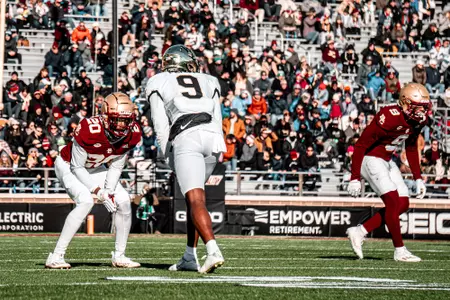
At Wake, Offensive Revolution Is No Other Option
October 20, 2022 | Football, #ForBoston Files
The Deacons play a full Run-Pass Option that's nearly impossible to defend.
Russell Wilson defied almost every expectation during his prime years with the Seattle Seahawks. An undersized quarterback, he was ridiculed for his height, and he dropped in the draft to the third round despite throwing for 3,000 yards per season in college. He was a low-cost acquisition by a team that had just signed a free agent quarterback to a big money contract, but after winning the starter's role by the first week of his rookie season, he redefined the position by appearing in consecutive Super Bowls with one championship ring.
That section of his legacy is entirely intact even after a precipitous drop in the Pacific Northwest led to a trade to Denver this season. It's easy to forget how he threw for 4,000 yards and 40 touchdowns as recently as 2020, but the way he played the position led to an influx of smaller, quicker quarterbacks capable of running the football.
Nearly every team at every level now designs plays for a quarterback who can scramble for yards with a run, but no team uses the run-pass option to the degree of No. 13-ranked Wake Forest, Boston College's opponent this upcoming Saturday.
"I haven't seen anyone do this style [of offense] other than Wake Forest," BC head coach Jeff Hafley explained this week. "The RPO game is in the NFL. When I left the NFL, the RPOs were there. These guys just do more, and I think this team does it better than most that I've seen, at least. This team does it better than anyone I've coached against."
That term - Run-Pass Option - refers to an innovative style that leaked its way into the NFL because of players like Wilson. It follows a similar mindset as the triple option seen mostly at service academies, in which the quarterback makes the decision to hand the ball to any one of several runners based on how he reads the defense, but where triple option rarely utilizes the pass, RPO forces a quarterback to incorporate different passing routes into the choice to either hand the ball to a runner or pull back into a passing option.
It revolves around field vision, which is why it's run out of a shotgun, with the decision itself based on how a player or series of players commits to the handoff option. As the defenders shift and move, the quarterback has to literally read their movements to identify the open space before either handing the ball to the running back or pulling back to their own body. Once they decide, the idea is that the defense is caught off-guard because it committed to the wrong player or wrong style of play, which in turn would create a hole for the next option in the RPO.
It was a bit of a gimmick when it first arrived, but Wilson used it to win a Super Bowl in his second season in Seattle. The next year, he returned to the championship and came within a yard of winning a second consecutive Lombardi Trophy, and three years later, Philadelphia used RPO nearly exclusively to gain over 500 yards to beat New England in Super Bowl LII. Now an entrenched part of the game, nearly every team has RPO as part of its overall toolbox to use opposite designed run or pass plays.
"I think it starts with the offensive line," Hafley said. "What they ask those guys to do because of how far [the offense] rides the back, they have to stay stout. They have to play pulled up [against] line movement and penetration, which a lot of teams try to do against them. Then obviously there's the quarterback, and you're going to ask him to see a lot. He's reading multiple things, and he's reading the extra defender coming into the box. He's counting numbers, and after he sees that, he's getting his eyes to other pieces to find out which side he should go to or which person he should go to. It takes time and experience and coaching and execution."
At the college level, Dave Clawson long utilized RPO when he was the head coach at Bowling Green, and he brought it with him to Wake Forest after leading the Falcons to the Mid-American Conference championship in 2013. Gifted a young, athletic quarterback in John Wolford, he slowly worked on converting a traditional pocket passer recruit into a dual-threat, and by 2017, Wake produced an eight-win season when Wolford ran for 683 yards and 10 touchdowns opposite a 29-score, 3,200-yard passing season.
Wake Forest had erased any semblance of a traditional, pro-style offense by then, and over the next few years, Jamie Newman and Sam Hartman tortured opposing defenses behind the RPO after he made the stalled, delayed hand-off into an artform. The way he deliberately held the football or waited in the backfield repeatedly forced attacking defenses to sit back and wait for his decision, and when he started 12 games in 2019, his 3,000-yard season with a combined 32 touchdowns included a 5-0 start capped by a 27-24 win over Boston College where he threw for 243 yards and two scores while running for 102 yards on 23 carries.
Hartman, meanwhile, had won the starting job as a true freshman in 2018 before losing it to Newman, but only playing in four games during a redshirt year in 2019 helped an inadvertent effect build Wake Forest's defending Atlantic Division champion from last year. He gained two extra years of eligibility after the COVID-19 season in 2020, and after throwing for 3,900 yards and 36 touchdowns for the Demon Deacons, he opted back into a fifth season that likely wouldn't have existed under normal circumstances.
"He's a tough kid who sees the game so well," Hafley said. "Those RPOs, the way he reads things, the way he gets rid of the ball, he's more athletic than people think. We learned that last year watching him live. He wants to stay in the pocket and throw, but he can run it too. He can run away from [defenders], but he keeps his eyes down the field. He's tough. He's in there blocking on some of the times that he hands off the ball, which seals the edge."
Now a fifth-year senior, Sam Hartman is the perfect quarterback for Dave Clawson's offense. A gimmick offense is now a championship-caliber unit that supplanted Clemson as the best team in the Atlantic Division. Even with the unexpected emergence of Syracuse, the Demon Deacons are still 5-1 with their only loss coming in a late September shootout against the Tigers. They've beaten Florida State and Liberty, and their last game saw them build a 38-0 lead over Army in the first three quarters en route to a 45-10 win.
Hartman threw a 26-yard touchdown pass in that game and finished with 246 yards despite only throwing 13-for-19 attempts. Four different Deacs carried the ball five times, and three ball carriers, including Hartman, rushed for 35 yards or more. Christian Turner had two touchdowns on the ground with Justice Ellison adding 96 yards and a score, but nobody carried more than 11 of Wake Forest's 42 rushing attempts. It was a scary, complete approach that included late mop-up duty by the second team, and it has the Deacs primed for another deep run through the Atlantic Division, regardless of what happens with this week's orange-tinged game in the Carolina to the south.
"You have to play complementary football," Hafley said. "It starts on special teams. We have to kick the ball much better than we have, and we have to punt it more efficiently. We have to make them drive the length of the field, and we have to eliminate explosives. They love those RPOs where they're not only throwing short ones, but they're taking shots down the field, and they make a lot of people pay."
Boston College and No. 13 Wake Forest kick off on Saturday at 3:30 p.m. from BB&T Stadium in Winston-Salem, North Carolina. The game can be seen on national television via the ACC Network with streaming options available through the ESPN online platform.
That section of his legacy is entirely intact even after a precipitous drop in the Pacific Northwest led to a trade to Denver this season. It's easy to forget how he threw for 4,000 yards and 40 touchdowns as recently as 2020, but the way he played the position led to an influx of smaller, quicker quarterbacks capable of running the football.
Nearly every team at every level now designs plays for a quarterback who can scramble for yards with a run, but no team uses the run-pass option to the degree of No. 13-ranked Wake Forest, Boston College's opponent this upcoming Saturday.
"I haven't seen anyone do this style [of offense] other than Wake Forest," BC head coach Jeff Hafley explained this week. "The RPO game is in the NFL. When I left the NFL, the RPOs were there. These guys just do more, and I think this team does it better than most that I've seen, at least. This team does it better than anyone I've coached against."
That term - Run-Pass Option - refers to an innovative style that leaked its way into the NFL because of players like Wilson. It follows a similar mindset as the triple option seen mostly at service academies, in which the quarterback makes the decision to hand the ball to any one of several runners based on how he reads the defense, but where triple option rarely utilizes the pass, RPO forces a quarterback to incorporate different passing routes into the choice to either hand the ball to a runner or pull back into a passing option.
It revolves around field vision, which is why it's run out of a shotgun, with the decision itself based on how a player or series of players commits to the handoff option. As the defenders shift and move, the quarterback has to literally read their movements to identify the open space before either handing the ball to the running back or pulling back to their own body. Once they decide, the idea is that the defense is caught off-guard because it committed to the wrong player or wrong style of play, which in turn would create a hole for the next option in the RPO.
It was a bit of a gimmick when it first arrived, but Wilson used it to win a Super Bowl in his second season in Seattle. The next year, he returned to the championship and came within a yard of winning a second consecutive Lombardi Trophy, and three years later, Philadelphia used RPO nearly exclusively to gain over 500 yards to beat New England in Super Bowl LII. Now an entrenched part of the game, nearly every team has RPO as part of its overall toolbox to use opposite designed run or pass plays.
"I think it starts with the offensive line," Hafley said. "What they ask those guys to do because of how far [the offense] rides the back, they have to stay stout. They have to play pulled up [against] line movement and penetration, which a lot of teams try to do against them. Then obviously there's the quarterback, and you're going to ask him to see a lot. He's reading multiple things, and he's reading the extra defender coming into the box. He's counting numbers, and after he sees that, he's getting his eyes to other pieces to find out which side he should go to or which person he should go to. It takes time and experience and coaching and execution."
At the college level, Dave Clawson long utilized RPO when he was the head coach at Bowling Green, and he brought it with him to Wake Forest after leading the Falcons to the Mid-American Conference championship in 2013. Gifted a young, athletic quarterback in John Wolford, he slowly worked on converting a traditional pocket passer recruit into a dual-threat, and by 2017, Wake produced an eight-win season when Wolford ran for 683 yards and 10 touchdowns opposite a 29-score, 3,200-yard passing season.
Wake Forest had erased any semblance of a traditional, pro-style offense by then, and over the next few years, Jamie Newman and Sam Hartman tortured opposing defenses behind the RPO after he made the stalled, delayed hand-off into an artform. The way he deliberately held the football or waited in the backfield repeatedly forced attacking defenses to sit back and wait for his decision, and when he started 12 games in 2019, his 3,000-yard season with a combined 32 touchdowns included a 5-0 start capped by a 27-24 win over Boston College where he threw for 243 yards and two scores while running for 102 yards on 23 carries.
Hartman, meanwhile, had won the starting job as a true freshman in 2018 before losing it to Newman, but only playing in four games during a redshirt year in 2019 helped an inadvertent effect build Wake Forest's defending Atlantic Division champion from last year. He gained two extra years of eligibility after the COVID-19 season in 2020, and after throwing for 3,900 yards and 36 touchdowns for the Demon Deacons, he opted back into a fifth season that likely wouldn't have existed under normal circumstances.
"He's a tough kid who sees the game so well," Hafley said. "Those RPOs, the way he reads things, the way he gets rid of the ball, he's more athletic than people think. We learned that last year watching him live. He wants to stay in the pocket and throw, but he can run it too. He can run away from [defenders], but he keeps his eyes down the field. He's tough. He's in there blocking on some of the times that he hands off the ball, which seals the edge."
Now a fifth-year senior, Sam Hartman is the perfect quarterback for Dave Clawson's offense. A gimmick offense is now a championship-caliber unit that supplanted Clemson as the best team in the Atlantic Division. Even with the unexpected emergence of Syracuse, the Demon Deacons are still 5-1 with their only loss coming in a late September shootout against the Tigers. They've beaten Florida State and Liberty, and their last game saw them build a 38-0 lead over Army in the first three quarters en route to a 45-10 win.
Hartman threw a 26-yard touchdown pass in that game and finished with 246 yards despite only throwing 13-for-19 attempts. Four different Deacs carried the ball five times, and three ball carriers, including Hartman, rushed for 35 yards or more. Christian Turner had two touchdowns on the ground with Justice Ellison adding 96 yards and a score, but nobody carried more than 11 of Wake Forest's 42 rushing attempts. It was a scary, complete approach that included late mop-up duty by the second team, and it has the Deacs primed for another deep run through the Atlantic Division, regardless of what happens with this week's orange-tinged game in the Carolina to the south.
"You have to play complementary football," Hafley said. "It starts on special teams. We have to kick the ball much better than we have, and we have to punt it more efficiently. We have to make them drive the length of the field, and we have to eliminate explosives. They love those RPOs where they're not only throwing short ones, but they're taking shots down the field, and they make a lot of people pay."
Boston College and No. 13 Wake Forest kick off on Saturday at 3:30 p.m. from BB&T Stadium in Winston-Salem, North Carolina. The game can be seen on national television via the ACC Network with streaming options available through the ESPN online platform.
Football: Grayson James Postgame Press Conference (Oct. 18, 2025)
Saturday, October 18
Football: Jordan McDonald Postgame Press Conference (Oct. 18, 2025)
Saturday, October 18
Football: Bill O'Brien Postgame Press Conference (Oct. 18, 2025)
Saturday, October 18
Field Hockey: MS Awareness Team Impact
Saturday, October 18














